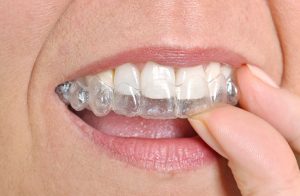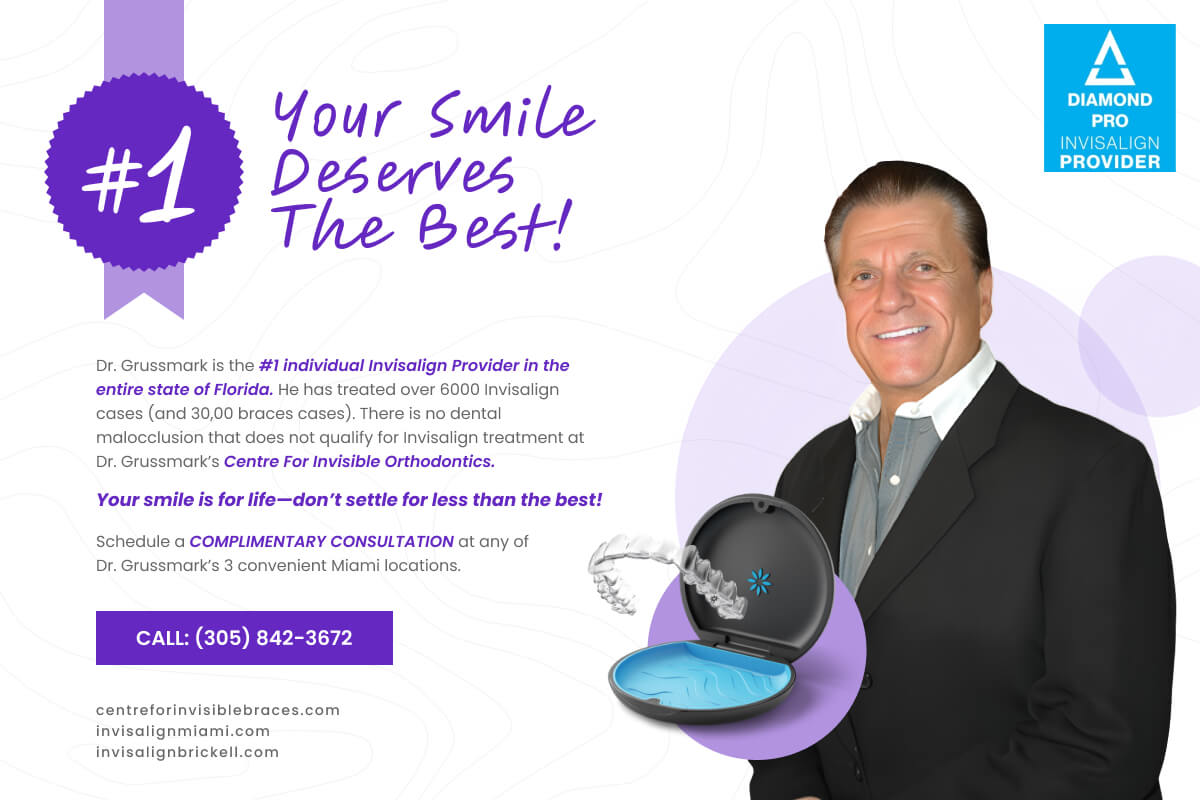
Tips for Resolving Invisalign Complications

Invisalign Aligner Tracking Issues
If you’re having trouble tracking your aligners or feel no progress is being made, Dr. Grussmark suggests evaluating your treatment and attempting the following solutions. If all else fails, schedule an appointment at our Miami, FL, office for an evaluation.
Causes of Invisalign Aligner Tracking Issues
Understanding the causes of these tracking problems is vital to addressing them effectively. Here are some common reasons behind Invisalign aligner tracking issues.
- Inconsistent Wear: Consistency is paramount to the success of your Invisalign treatment. Failing to wear your aligners for the recommended 20 to 22 hours can disrupt the gradual movement of your teeth, resulting in tracking problems.
- Accelerated Progression: While it’s natural to be eager for results, progressing through your aligner sets too quickly can hinder proper alignment. Each set gently guides your teeth through specific movements, and rushing this process can lead to tracking difficulties.
- Misplaced Attachments: Aligner attachments are tooth-colored bumps that aid in the precise movement of your teeth. If an attachment becomes dislodged or improperly placed, it can affect the aligner’s ability to guide your teeth accurately.
- Residual Gaps: If your aligners aren’t fitting snugly against your teeth, gaps can form, preventing the desired movement. This can occur due to improper placement, wear patterns, or teeth not fitting snugly within the aligners.
- Poor Oral Hygiene: Maintaining excellent oral hygiene is crucial during Invisalign treatment. Accumulation of plaque, debris, or food particles on your teeth or aligners can impact their fit and movement.
Solutions to Invisalign Aligner Tracking Issues

- Follow Wear Guidelines: Consistent wear ensures the necessary gradual movement of your teeth.
- Maintain Progression: Resist the urge to rush through your aligner sets. Allow your teeth ample time to adjust to each stage of movement before advancing to the next set.
- Address Attachment Concerns: If you suspect an attachment is causing tracking problems, contact Dr. Grussmark’s office for assessment. They can reposition or replace attachments as needed.
- Ensure Proper Fit: Check that your aligners fit snugly against your teeth. If gaps or discomfort persist, consult Dr. Grussmark to ensure proper fit and alignment.
- Maintain Oral Hygiene: Regularly clean your teeth and aligners to prevent buildup that may impact tracking. Follow Dr. Grussmark’s oral hygiene recommendations.
Other Common Invisalign Complications and Solutions
Complication: Aligner Irritation and Discomfort
Solution: Some initial discomfort or irritation may occur as your mouth adjusts to the presence of aligners. Dr. Grussmark recommends using orthodontic wax to alleviate friction and soreness in your gums. Over time, your mouth will adapt, and any discomfort should subside.
Complication: Aligner Attachments Feeling Strange
Solution: Aligner attachments, while essential for movement, might feel unusual against your cheeks and lips. Remember that these attachments play a crucial role in your treatment. With time, the sensation will become less noticeable as you get accustomed to them.
Complication: Aligner Speech Changes
Solution: It’s normal to experience slight changes in your speech when wearing aligners, especially during the initial days. Practice speaking slowly and clearly. As your tongue adjusts to the aligners, your speech will return to normal.
Complication: Aligner Allergies
Solution: Although rare, some individuals might experience allergies to the aligner material. If you notice persistent redness, swelling, or irritation, discontinue use and consult with Dr. Grussmark’s team to determine if an allergy is the cause.
Preventing Invisalign Complications
Adhere to Wear Guidelines
Consistently wearing your Invisalign aligners for the recommended 20 to 22 hours is crucial for optimal results. Deviating from this guideline can lead to delays in your treatment progress and potential complications.
Follow Care Instructions
Maintaining excellent oral hygiene is essential. Brush and floss your teeth after every meal before reinserting your aligners. Clean your aligners as instructed by Dr. Grussmark to prevent bacterial buildup.
Store Aligners Properly
When not wearing your aligners, store them in their designated case to prevent loss or damage. Avoid placing them in tissues, napkins, or pockets where they may be accidentally thrown away or damaged.
Remove Aligners When Eating
Remove your aligners before eating or drinking anything other than water. This prevents staining, damage, and potential complications from food particles getting trapped.
Communicate with Dr. Grussmark
Maintain open communication with Dr. Grussmark and his team. If you experience discomfort, concerns, or notice changes in your aligners, reach out for guidance promptly. Regular check-ins with Dr. Grussmark are also essential for monitoring your progress and addressing potential issues before they escalate.
Frequently Asked Questions
How can I ensure I'm wearing my Invisalign aligners for the recommended duration each day?
Establishing a routine is essential. Set alarms or reminders on your phone to signal when it’s time to remove or reinsert your aligners. Integrating aligner wear into your daily schedule, such as before or after meals and before bedtime, can help you achieve the recommended 20 to 22 hours.
What should I do if I accidentally leave my Invisalign aligners out for an extended period?
If you inadvertently leave your aligners out for an extended period, such as during a meal or a special occasion, try to wear them for an extra hour or two each day to compensate. Consistency is key, so aim to maintain the recommended overall wear time by extending it on subsequent days.
Can I switch to a new Invisalign aligner set earlier than instructed?
It’s best to follow the schedule provided by your orthodontist. Each aligner set helps gradually move your teeth according to a specific plan. Prematurely switching to a new set can disrupt the alignment process and lead to complications. If you have concerns about your aligner progress, consult Dr. Grussmark’s office for guidance.
Are there specific foods I should avoid to prevent Invisalign complications?
While you have more dietary flexibility with Invisalign compared to traditional braces, it’s best to remove your aligners before eating or drinking anything other than water. This prevents staining and damage to the aligners. Sticky or hard foods that could damage the aligners should also be avoided.
Ensure a Successful Invisalign Treatment with Dr. Grussmark
As you navigate potential challenges and triumphs, remember you’re not alone. Dr. Grussmark and his experienced team are here to provide the guidance, expertise, and support needed to overcome obstacles and embrace your smile transformation.
Call our Miami, FL, office at 305-842-3672 to schedule an appointment and learn more helpful Invisalign troubleshooting tips. We welcome patients from Brickell, Coral Gables, and Miami Beach, FL.



